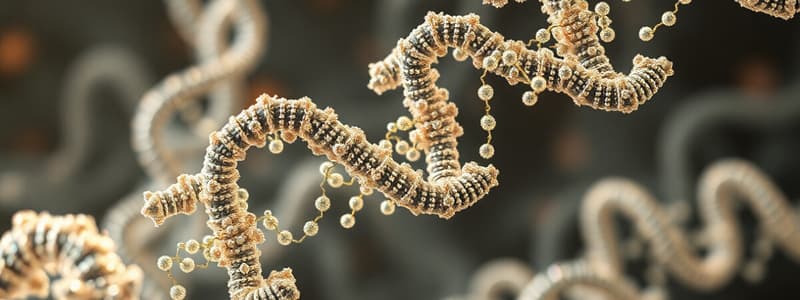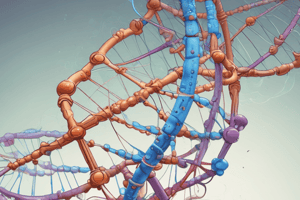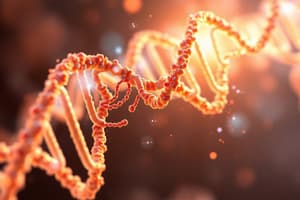Podcast
Questions and Answers
What happens to transferrin receptor mRNA when there is sufficient intracellular Fe2+?
What happens to transferrin receptor mRNA when there is sufficient intracellular Fe2+?
- It is stabilized and persists in the cytoplasm.
- It is translated into proteins.
- It is degraded. (correct)
- It is transported to the nucleus.
Which region of the ferritin mRNA is critical for the regulation of translation under low iron conditions?
Which region of the ferritin mRNA is critical for the regulation of translation under low iron conditions?
- Coding region
- Intron
- 3'-UTR
- 5'-UTR (correct)
What role does the Iron Response Element-binding protein (IRE-BP) play in relation to transferrin receptors?
What role does the Iron Response Element-binding protein (IRE-BP) play in relation to transferrin receptors?
- Enhances mRNA synthesis
- Dissociates from the 3'-UTR in the presence of Fe2+ (correct)
- Binds Fe2+ to stabilize mRNA
- Initiates transcription of TfR mRNA
What is the consequence of RNA secondary structure in regards to the transferrin receptor?
What is the consequence of RNA secondary structure in regards to the transferrin receptor?
What is the primary function of the poly(A) tail in mRNA?
What is the primary function of the poly(A) tail in mRNA?
How does the presence of Fe2+ affect the stability of transferrin receptor mRNA?
How does the presence of Fe2+ affect the stability of transferrin receptor mRNA?
The mature mRNA of transferrin receptors includes which of the following structural elements?
The mature mRNA of transferrin receptors includes which of the following structural elements?
What happens to ferritin mRNA when intracellular iron levels are low?
What happens to ferritin mRNA when intracellular iron levels are low?
What defines a unique characteristic of RNA as opposed to DNA?
What defines a unique characteristic of RNA as opposed to DNA?
Which component is essential for catalysis by RNA molecules?
Which component is essential for catalysis by RNA molecules?
What is the primary role of messenger RNA (mRNA) in the cell?
What is the primary role of messenger RNA (mRNA) in the cell?
Which of the following best describes the stability of RNA compared to DNA?
Which of the following best describes the stability of RNA compared to DNA?
Which type of RNA is primarily involved in splicing introns from pre-messenger RNA?
Which type of RNA is primarily involved in splicing introns from pre-messenger RNA?
What chemical change differentiates uracil from thymine?
What chemical change differentiates uracil from thymine?
How is RNA primarily regulated in terms of its function and usage within the cell?
How is RNA primarily regulated in terms of its function and usage within the cell?
What percentage of total RNA in a typical cell is ribosomal RNA (rRNA)?
What percentage of total RNA in a typical cell is ribosomal RNA (rRNA)?
Which biological role is associated with catalytic RNA?
Which biological role is associated with catalytic RNA?
What is the significance of a 5' cap and poly-A tail in mRNA?
What is the significance of a 5' cap and poly-A tail in mRNA?
What is a primary feature of RNA's secondary structure?
What is a primary feature of RNA's secondary structure?
What is the approximate mass of RNA in a single cell?
What is the approximate mass of RNA in a single cell?
Flashcards
What is Ribonucleic Acid (RNA)?
What is Ribonucleic Acid (RNA)?
RNA is a nucleic acid that plays a crucial role in gene expression. It's a single-stranded molecule, unlike DNA, and it's involved in the transfer of genetic information from DNA to proteins.
How does RNA differ from DNA in its chemical structure?
How does RNA differ from DNA in its chemical structure?
Unlike DNA, RNA uses ribose sugar instead of deoxyribose. The difference lies in the presence of a hydroxyl group at the 2' position of ribose.
What is the difference between uracil and thymine in RNA?
What is the difference between uracil and thymine in RNA?
In place of thymine, RNA contains uracil. Uracil lacks a methyl group found in thymine.
What is Messenger RNA (mRNA)?
What is Messenger RNA (mRNA)?
Messenger RNA (mRNA) carries the genetic code from DNA to the ribosomes, where it directs protein synthesis.
Signup and view all the flashcards
What is Ribosomal RNA (rRNA)?
What is Ribosomal RNA (rRNA)?
Ribosomal RNA (rRNA) forms the structural framework of ribosomes, which are the protein synthesis machinery in the cell.
Signup and view all the flashcards
What is Transfer RNA (tRNA)?
What is Transfer RNA (tRNA)?
Transfer RNA (tRNA) acts as an adapter molecule, bringing specific amino acids to the ribosomes to be incorporated into the growing protein chain.
Signup and view all the flashcards
What is Small Nuclear RNA (snRNA)?
What is Small Nuclear RNA (snRNA)?
Small nuclear RNA (snRNA) plays a critical role in splicing introns from pre-messenger RNA, a crucial step in the processing of mRNA.
Signup and view all the flashcards
What is Small Nucleolar RNA (snoRNA)?
What is Small Nucleolar RNA (snoRNA)?
Small nucleolar RNA (snoRNA) helps process and modify ribosomal RNA, ensuring proper function of ribosomes.
Signup and view all the flashcards
How can RNA act as a catalyst?
How can RNA act as a catalyst?
Certain RNA molecules can act as catalysts, driving chemical reactions. A famous example is the self-splicing introns.
Signup and view all the flashcards
How is the amount of RNA regulated in a cell?
How is the amount of RNA regulated in a cell?
The amount of RNA present in a cell is tightly regulated. This control is essential for efficient and accurate gene expression.
Signup and view all the flashcards
mRNA (messenger RNA)
mRNA (messenger RNA)
A type of RNA that carries genetic information from DNA to ribosomes, where proteins are synthesized.
Signup and view all the flashcards
Promoter
Promoter
A sequence of DNA that controls the transcription of a gene.
Signup and view all the flashcards
Intron
Intron
A non-coding region within a gene that is spliced out during mRNA processing.
Signup and view all the flashcards
Exon
Exon
A coding region within a gene that is retained in the mature mRNA after splicing.
Signup and view all the flashcards
5'-UTR (5' Untranslated Region)
5'-UTR (5' Untranslated Region)
A region of mRNA that is located before the start codon (AUG) and is not translated into protein.
Signup and view all the flashcards
3'-UTR (3' Untranslated Region)
3'-UTR (3' Untranslated Region)
A region of mRNA that is located after the stop codon (UGA) and is not translated into protein.
Signup and view all the flashcards
Transferrin
Transferrin
A protein that binds to iron and transports it in the bloodstream.
Signup and view all the flashcards
Transferrin Receptor (TfR)
Transferrin Receptor (TfR)
A protein on cell surfaces that binds transferrin, allowing iron to enter the cell.
Signup and view all the flashcards
Iron Response Element (IRE)
Iron Response Element (IRE)
A regulatory element found in the 3'-UTR of certain mRNAs, such as transferrin receptor mRNA, involved in iron regulation.
Signup and view all the flashcards
Iron Response Element-binding Protein (IRE-BP)
Iron Response Element-binding Protein (IRE-BP)
A protein that binds to IREs and regulates mRNA stability and translation based on iron levels.
Signup and view all the flashcardsStudy Notes
RNA Structure and Function
- RNA is a product of DNA transcription
- A cell contains 10 times more RNA than DNA
- Multiple types of RNA play various roles in gene expression
- RNA differs from DNA in chemical structure, physical properties, and biological roles
Aims of the Lecture
- Describe the physical and functional features of RNA
- Explain the biological functions of RNA within a cell
- Outline the roles of untranslated regions (UTRs)
RNA Chemical Structure
- RNA uses ribose instead of deoxyribose in its structure
- The 2'-hydroxyl group in ribose makes RNA less stable compared to DNA
- The base uracil replaces thymine in RNA
- Uracil lacks the methyl group present in thymine
Biological Roles of RNA
- Transferring information from DNA to proteins (messenger RNA, mRNA)
- Protein synthesis (ribosomal RNA, rRNA; transfer RNA, tRNA)
- Involved in processing messenger RNA (small nuclear RNA, snRNA; small nucleolar RNA, snoRNA)
- Involved in splicing introns from pre-messenger RNA
- Important as catalytic RNA (self-splicing introns; natural/artificial ribozymes)
RNA Content of a Cell
- A single cell contains ~10 pg (10-11 g) of RNA
- 80-85% is ribosomal RNA
- 10-15% are low molecular weight species (tRNAs, small nuclear RNAs)
- 1-5% is messenger RNA
RNA Physical Properties
- Generally single-stranded
- Can form complex structures through base-pairing (secondary and tertiary structure)
RNA Secondary Structure Formation
- For each type, palindrome sequence and self-complementary base-pairing plays a key role to form.
RNA Regulation
- The amount/usage of RNA is important to function
- Regulating synthesis: This is rapid, as shown by the lac operon
- Regulating degradation: Examples like transferrin receptor mRNA
- Regulating translation efficiency: Proteins control usage of certain RNAs, as seen in ferritin mRNA
Eukaryotic mRNA-Encoding Genes
- mRNA is transcribed from DNA
- mRNA contains 5' UTR, coding region, and 3' UTR sequences
- UTRs are untranslated and play significant regulatory roles
- mRNA moves from the nucleus to the cytoplasm for translation
The Transferrin Receptor
- Iron in the blood binds to transferrin and is transported into cells through a receptor
- If sufficient intracellular iron is present, the mRNA is degraded
RNA 2° Structure Regulation
- Intracellular iron (Fe2+) regulates transferrin receptor (TfR) mRNA degradation
- Iron Response Element (IRE)-Binding protein (IRE-BP) binds to mRNA regions in response to iron availability
- The binding/release status of IRE-BP controls mRNA stability
RNA Secondary Structure and Regulation of Translation
- Ferritin binds Fe2+
- Low iron causes IRE-BP to bind to the IRE sequence - preventing translation
- High iron causes IRE-BP to release from the IRE sequence - allowing for ferritin translation
Summary
- RNA 2° structure is important for catalysis, organization, and recognition
- RNA 2° structure impacts stability (as seen with the transferrin receptor) and translation (as seen with ferritin)
Intended Learning Outcomes
- Define and describe the basic chemical and functional properties of RNA and explain how it differs from DNA
- Understand how RNA forms secondary structure and builds three-dimensional structures
- Understand the role of secondary/tertiary structure in RNA's biological roles
Studying That Suits You
Use AI to generate personalized quizzes and flashcards to suit your learning preferences.




